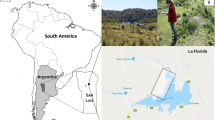Summary
Wood ants of theFormica rufa species complex are typically bound to woodland habitats and their eventual colonization of more open habitats depends on the presence of a sufficient number of woody plants. Computer simulations of the long-term development of large wood ant populations in woodland systems of differing structure were performed. A cellular, stochastic automation model simulated the alternatives of a compact, coherent woodland system and a fragmented, coarse-grained woodland system. The simulation of a compact woodland system gave evidence that disruptive selection alone may be sufficient to produce two distinct ectotypes, which are known asFormica rufa andFormica polyctena, even if there is a full fertility of the crosses. The simulation of a fragmented, coarse-grained woodland system has supported the view, that a high local frequency of nests with intermediate phenotypes might be explainable by a particular woodland pattern which favour mixed strategies. It was shown that queen dominance and intraspecific social parasitism are likely to be important factors in the dynamics of large wood ant populations.
Similar content being viewed by others
References
Betrem, J. G., 1960. Über die Systematik derFormica-rufa-Gruppe.Tijdschr. Entomol. 104:51–81.
Carlin, N. F. and B. Hölldobler, 1986. The kin recognition system of carpenter ants (Camponotus spp.), I. Hierarchical cues in small colonies.Behav. Ecol. Sociobiol. 19:123–134.
Carlin, N. F. and B. Hölldobler, 1987. The kin recognition system of carpenter ants (Camponotus spp.), II. Larger colonies.Behav. Ecol. Sociobiol. 20:123–134.
Dlussky, G., 1967. Muravi rodaFormica.Izdatel'stvo “Nauka”, Moskow 1967.
Elmes, G. W. and M. V. Brian, 1991. The importance of the egg-mass to the activity of normal queens and microgynes ofMyrmica rubra L. (Hym. Formicidae).Ins. Soc. 38:51–62.
Francke, W., M. Bühring and K. Horstmann, 1980: Untersuchungen über Pheromone beiFormica polyctena (Förster).Zeitschr. Naturforsch., Ser. C, 35:829–831.
Gößwald, K., 1951. Über den Lebenslauf von Kolonien der Roten Waldameise.Zool. Jb. Abt. Syst. Ökol. Tiere 80:27–63.
Gößwald, K., 1953. Über Versuche zur Verwendung von Hilfsameisen zwecks Vermehrung der nützlichen Kleinen Roten Waldameise.Zeitschr. angew. Entomol. 34:1–44.
Gößwald, K., 1957. Über die biologischen Grundlagen der Zucht und Anweiselung junger Königinnen der Kleinen Roten Waldameise nebst praktischen Erfahrungen.Waldhygiene 2:33–53.
Gößwald, K., 1960. Untersuchungen zum Paarungs- und Adoptionsverhalten verschiedenerFormica -Arten.Verh. XI Int. Kongr. Ent. Wien 1:612–617.
Gößwald, K., 1981. Artunterschiede der Waldameisen in Aussehen, Lebensweise, Organisation, Verhalten, Nest- und Strassenbau, Ökologie und Verbreitung.Merkbl. Waldhygiene, Würzburg 1:1–32.
Haeseler, V., 1982. Über die weitere Besiedlung der Nordseeinsel Mellum durch Wespen, Ameisen und Bienen (Hymenoptera).Schr. naturw. Ver. Schlesw.-Holst. 52:57–67.
Keller, L. and K. G. Ross, 1993. Phenotypic plasticity and “cultural transmission” of alternative social organizations in the fire antSolenopsis invicta.Behav. Ecol. Sociobiol. 33:121–129.
Kutter, H., 1969. Die Sozialparasitischen Ameisen der Schweiz (Neujahrsblatt 1969, No. 171):Vierteljahresschr.Naturforsch. Ges. Zurich 113:1–62.
Mabelis, A., 1979. Wood ant wars.Netherl. J. Zool. 29:451–620.
Mabelis, A., 1994. Flying as survival strategy for wood ants in a fragmented landscape (Hymenoptera, Formicidae).Mem. Zool. 48:147–170.
Marikovsky, P. I., 1961. Material on sexual biology of the antFormica rufa L.Ins. Soc. 8:23–30.
Otto, D., 1960. Statistische Untersuchungen über die Beziehungen zwischen Königinnenzahl und Arbeiterinnengrösse bei den Roten Waldameisen (“engereFormica-rufa-Gruppe.”).Biol. Zentralbl. 79:719–739.
Otto, D., 1962. Die Roten Waldameisen. 151 pp. Ziemsen Verlag, Wittenberg Lutherstadt.
Otto, D., 1968. Zur Verbreitung der Arten derFormica rufa Linnaeus-Gruppe.Beitr. Ent. Berlin 18:671–692.
Rosengren, R. and P. Pamilo, 1983. The evolution of polygyny and polydomy in mound-buildingFormica ants.Acta Entomol. Fenn. 42:65–77.
Seifert, B., 1986. Vergleichende Untersuchungen zur Habitatwahl von Ameisen im mittleren und südlichen Teil der DDR.Abh. Ber. Naturkundemus. Görlitz 59/5:1–124.
Seifert, B., 1991. The phenotypes of theFormica rufa complex in East Germany.Abh. Ber. Naturkundemus. Görlitz 65/1:1–27.
Woyciechowski, M., 1990. Nuptial flights of several ant species and their aerial aggregations (Hymenoptera, Formicidae).Acta zool. cracov., Krakow 33:555–564.
Yarrow, I. H. H., 1955. The British ants allied toFormica rufa L.Trans. Soc. Brit. Entomol. 121:1–48.
Author information
Authors and Affiliations
Rights and permissions
About this article
Cite this article
Höfener, C., Seifert, B. & Krüger, T. A genetic model for disruptive selection on colony social organisation, reproduction, and ecotype distribution in wood ants inhabiting different woodland habitats. Ins. Soc 43, 359–373 (1996). https://doi.org/10.1007/BF01258409
Received:
Revised:
Accepted:
Issue Date:
DOI: https://doi.org/10.1007/BF01258409




